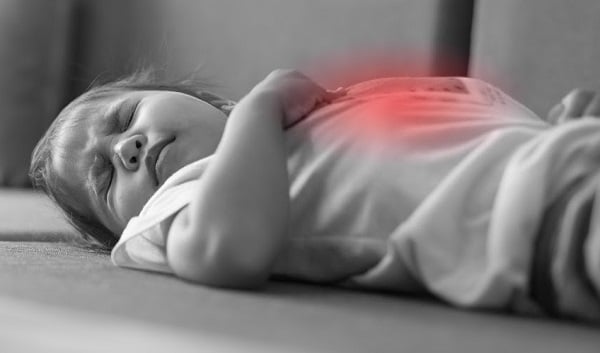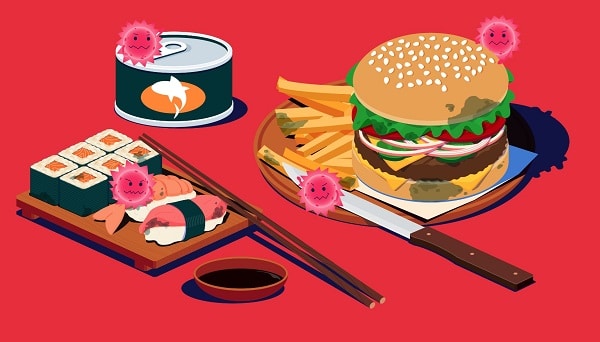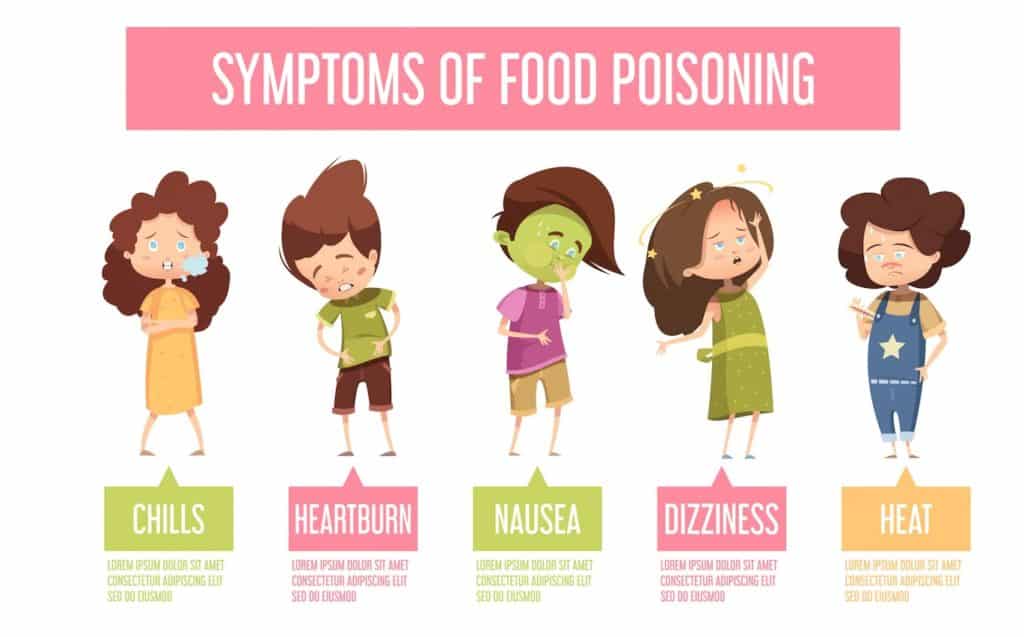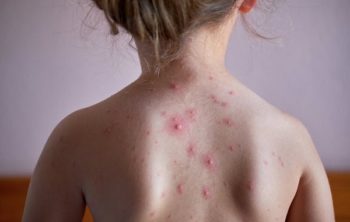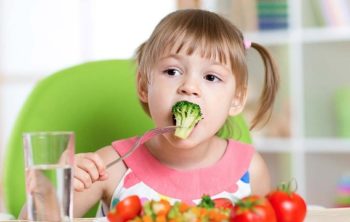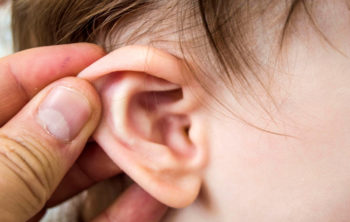Food poisoning in children can be a scary experience for parents. It can be hard to know what to do when your child is sick, and food poisoning can sometimes lead to more serious health problems. In this blog post, we will discuss the causes of food poisoning in children, the symptoms to look out for, and how to best treat your child if they become ill. We hope this information will help you keep your child safe and healthy.
Food poisoning is a common ailment that can affect anyone, but it poses a special risk to young children. Because their immune systems are still developing, they are more susceptible to the effects of food poisoning. In fact, according to the Centers for Disease Control and Prevention (CDC), food poisoning affects about 48 million people in the United States each year, and of those people, 128,000 are hospitalized and 3,000 die from their illness. It is important for parents to be aware of the symptoms of food poisoning in children, how to diagnose it, and how to treat it.
Contents
What is food poisoning?
When we think of food poisoning, we usually think of the typical gastroenteritis – an infection of the gut (intestines) – which usually causes diarrhoea with or without being sick (vomiting). However, sometimes other symptoms or problems, such as feeling sick (nausea) and tummy (abdominal) cramping pain, can arise from eating contaminated food.
So what is food poisoning exactly? Food poisoning occurs when food or water contaminated with harmful germs (microbes), poisons (toxins) or chemicals is eaten or drunk. These contaminants can come from a number of sources, including contaminated soil, contaminated water, infected animals, and even other humans who are carrying the bacteria.
Symptoms of food poisoning can range from mild to severe, and usually depend on the type of contaminant that was consumed. For example, E. coli food poisoning often leads to severe diarrhoea and stomach cramps, while salmonella food poisoning may cause fever, diarrhoea and vomiting. In some cases, food poisoning can even be life-threatening. Also, food poisoning can be caused by:
Bacteria:
There are many different types of bacteria that can cause food poisoning, but Campylobacter is by far the most common in the UK. Other bacteria that can cause food poisoning include Salmonella, Escherichia coli (usually shortened to E. coli), Listeria, Shigella, and Clostridium perfringens. Symptoms of food poisoning caused by these bacteria may include nausea, vomiting, diarrhoea, and abdominal pain. If you think you may have been exposed to any of these bacteria, it is important to see a doctor as soon as possible for treatment.
Viruses:
There are a number of different viruses that can contaminate food and cause food poisoning. These include norovirus, rotavirus, and a variety of other less well-known viruses. All of these viruses share one common trait: they are all incredibly contagious. This means that if just one person in a group of people is infected with a virus, it is highly likely that the rest of the group will also become infected.
Parasites:
Parasites are living things (organisms) that live within, or on, another organism. Examples include cryptosporidium, Entamoeba histolytica and giardia parasites. Food poisoning caused by parasites is more common in the developing world.
In the UK, the most common parasite that can cause food poisoning is toxoplasma. This is a parasite that lives in the gut of a number of animals, including cats. Food poisoning can occur if food or water is contaminated with the stools (faeces) of infected cats. It can also occur if raw or undercooked meat from another animal that is infected with toxoplasma is eaten.
Symptoms of toxoplasmosis include fever, muscle pain, headache and sore throat. The illness usually lasts for 1-2 weeks. In some cases, toxoplasmosis can lead to more serious problems, such as inflammation of the brain (encephalitis) or blindness.
Toxins and chemicals:
Toxins produced by bacteria can also contaminate food, as well as the bacteria themselves. For example, the bacterium Staphylococcus aureus can contaminate ice cream and its toxins can lead to food poisoning. The bacterium Bacillus cereus can contaminate rice. If contaminated rice is reheated and eaten, the toxins produced can lead to food poisoning.
There are many different types of toxins that can contaminate food, including:
- Bacterial toxins
- Mycotoxins (fungal toxins)
- Plant toxins
- Animal toxins.
Toxins can also come from chemicals that are used in food production or processing, such as:
- Pesticides
- Herbicides
- Fungicides
- Cleaning agents
- Food additives.
Note: this is a general leaflet about food poisoning. There are separate leaflets that give more details about some of the different microbes that cause food poisoning.
How does food become contaminated?
There are several ways that food can become contaminated:
- Not storing food correctly or at the correct temperature – for example, not refrigerating food. This is particularly a problem for meat and dairy products.
- Inadequate cooking of food (undercooking or not cooking hot enough). Germs (bacteria) are often found in raw meat, including poultry. Adequate cooking usually kills the bacteria.
- Contamination by someone preparing the food who has not followed food hygiene rules and has not washed their hands properly.
- Exposure to contaminated water or sewage.
- Use of contaminated utensils or surfaces, such as cutting boards.
- Exposure to insects or other animals, such as rodents.
- Radiation exposure.
- Chemical contamination, such as from cleaning products or pesticides.
- Allergens, such as peanuts or shellfish.
- Intentional contamination, such as sabotage or terrorism.
Any of these can cause foodborne illness, also called food poisoning. Symptoms vary depending on the type of contamination, but often include nausea, vomiting, diarrhea, and abdominal pain. In severe cases, hospitalization may be necessary. In some cases, contaminated food can even lead to death.
How does water become contaminated?
One of the main ways that water can become contaminated is through contact with human or animal stools. This is especially a problem in countries with poor sanitation. In these countries, it’s often the case that food is prepared using contaminated water. This means that your child should be particularly careful when consuming any kind of food or drink in such countries. To reduce the risk of contamination, your child should avoid:
- Drinking tap water.
- Having ice cubes in drinks (as the ice may have been made from tap water).
- Brushing teeth with tap water.
- Eating salads (as the lettuce, tomatoes, etc, may have been washed in contaminated water).
- Eating uncooked vegetables (as they may have been washed in contaminated water).
If you’re unsure about the safety of the water supply in a particular country, it’s always best to err on the side of caution and boiled or bottled water instead.
How common is Food Poisoning In Children?
As mentioned above, food poisoning is quite common in the UK. In fact, according to the Food Standards Agency (FSA), there are more than 500,000 cases of food poisoning in the UK every year from known causes. If unidentified causes were included as well, this figure would be even higher. So, if you experience symptoms of food poisoning, you’re certainly not alone.
However, that doesn’t mean that you should just brush it off as no big deal. Food poisoning can cause serious illness and, in some rare cases, death. Therefore, it’s important to be aware of the signs and symptoms and to seek medical help if you think you may have food poisoning. With that said, let’s take a closer look at food poisoning and some of the things you should know about it.
How long does it take for food poisoning to develop?
The incubation period is the time between consuming contaminated food and experiencing symptoms of food poisoning. For most types of food poisoning, symptoms typically appear within one to three days after eating the contaminated food. However, in some cases, the incubation period can be as long as 90 days. This is particularly true for certain types of foodborne illnesses, such as those caused by the bacteria Listeria monocytogenes.
What are the usual symptoms of food poisoning in children?
There are many different types of food poisoning, each with its own symptoms. However, there are some general symptoms that are common to most types of food poisoning. These include nausea, vomiting, stomach cramps, diarrhea, and fever. Symptoms typically occur within 1 to 3 days after eating contaminated food.
If you experience any of these symptoms after eating, it is possible that you have food poisoning. If the symptoms are severe, or if you develop a rash or other unusual symptoms, it is important to see a doctor right away. Treatment for food poisoning will vary depending on the cause, but may include antibiotics or other medications. In severe cases, hospitalization may be necessary.
Symptoms of lack of fluid in the body (dehydration):
If you suspect your child is dehydrated, it is important to seek medical advice as soon as possible. Children can become severely dehydrated very quickly, and this can be very dangerous. Mild dehydration is more common and can usually be easily reversed by drinking plenty of fluids.
Dehydration can cause a number of symptoms in children, including:
- Passing little urine.
- A dry mouth.
- A dry tongue and lips.
- Fewer tears when crying.
- Sunken eyes.
- Weakness or lethargy.
- Irritability.
If your child is showing any of the following symptoms, they may be severely dehydrated and you should seek medical attention immediately:
- Drowsiness.
- Pale or mottled skin.
- Cold hands or feet.
- Very few wet nappies.
- Fast (but often shallow) breathing.
Dehydration is very serious, especially in young children, and can quickly become a medical emergency. If you think your child may be dehydrated, don’t wait – seek medical help immediately.
Dehydration is more likely to occur in:
- Dehydration is more likely to occur in babies under the age of 1 year, particularly those who are under 6 months old. This is because babies don’t need to lose much fluid to lose a significant proportion of their total body fluid.
- Babies who were born at a low birth weight and who have not caught up with their weight are also at risk of dehydration.
- Breastfed babies who have stopped breastfeeding during their illness are also at risk of dehydration.
- Any baby or child who does not drink much when they have a gut infection (gastroenteritis) is also at risk of dehydration.
- Finally, any baby or child with severe diarrhoea and vomiting is also at risk of dehydration. (For example, if they have passed five or more diarrhoeal stools and/or vomited two or more times in the last 24 hours.)
How is food poisoning diagnosed and are tests required?
Most cases of food poisoning are mild and will resolve on their own. However, it is important to seek medical advice if your child is unwell, especially if they are becoming dehydrated. The doctor may ask you questions about recent travel abroad or any ways that your child may have eaten or drunk contaminated food or water.
The doctor will also usually check your child for signs of dehydration. Treatment for food poisoning typically involves rest and drinking plenty of fluids. In more severe cases, hospitalization may be necessary. If you think your child has food poisoning, contact your doctor or seek medical attention immediately.
Prevention of food poisoning typically involves good hygiene practices when preparing food and avoiding consuming contaminated food or water. Travellers should also be aware of the risk of food poisoning and take steps to avoid it.
A stool sample may be collected and sent to a laboratory for examination if your doctor suspects an infection. This can help to identify the cause of the infection. A stool sample is not always needed. Your doctor is likely to suggest one in certain situations, such as:
- If your child has recently been abroad.
- If your child is very unwell.
- If your child has blood or pus in their stools.
- If your child’s diarrhoea is not settling after a week.
- If your child has recently been in hospital or had antibiotic treatment.
- If your child has another medical condition, particularly one which affects their immune system.
Collecting a stool sample from your child is usually straightforward. Your doctor will provide you with a special kit, which contains everything you need. The kit will also include instructions on how to collect the sample. It is important to follow these instructions carefully, as this will ensure that the sample is of good quality and can be used for testing.
Once the sample has been collected, it needs to be sent to the laboratory as soon as possible. The laboratory will then examine the sample and provide a report to your doctor. This report will help to identify the cause of the infection and any possible treatments.
When should I seek medical advice?
If your child has gastroenteritis, the most important thing is to make sure they stay hydrated. In many cases, no medical treatment is necessary and symptoms will improve within a few days. However, you should seek medical attention if:
- Your child is under 6 months old
- Your child has an underlying medical condition
- Your child has a high fever
- Your child is being sick (vomiting) and is unable to keep fluids down, you should seek medical advice.
- If there is blood in their diarrhoea or vomit, you should seek medical advice.
- Your child has severe tummy (abdominal) pain, you should seek medical advice.
- If infections caught abroad, you should seek medical advice.
- Your child has severe symptoms, or if you feel that their condition is becoming worse, you should seek medical advice.
- Your child’s symptoms are not settling (for example, vomiting for more than 1-2 days, or diarrhoea that does not start to settle after 3-4 days), you should seek medical advice.
- If there are any other symptoms that you are concerned about, you should seek medical advice.
What is the treatment for food poisoning in children?
The main treatment for food poisoning is rest and plenty of fluids. Drinking clear fluids will help to prevent dehydration. Dehydration can occur when you lose more fluid than you take in and your body does not have enough water or other fluids to carry out its normal functions. Symptoms of dehydration include a dry mouth, tiredness, dizziness and passing little urine. In severe cases, it can lead to fits (seizures), brain damage and death.
If vomiting and diarrhoea persist for more than a few days, it is important to see a doctor as further complications could develop, such as dehydration or gut perforation (a hole in the gut). Treatment for more severe cases may require hospitalisation and intravenous (into the vein) fluids. In very rare cases, surgery may be needed.
Most people with food poisoning make a full recovery within a few days. However, some types of food poisoning can have long-term effects. For example:
- Campylobacter infections can sometimes lead to a debilitating condition called Guillain-Barré syndrome. This is a rare but serious neurological condition that can cause paralysis (muscle weakness).
- Salmonella infections can sometimes lead to a condition called reactive arthritis, which causes pain and swelling in the joints. This can last for several months or even years.
Prevention of food poisoning is better than cure. Good hygiene practices when handling food, such as washing hands and surfaces, are essential in preventing the spread of infection. Food should be cooked thoroughly to kill any bacteria that may be present.
Raw meat, eggs and unpasteurised dairy products should be avoided if possible, particularly by vulnerable groups such as young children, pregnant women, the elderly and those with weakened immune systems. It is also important to avoid cross contamination by using separate chopping boards for raw meat and ready-to-eat foods.
Fluids to prevent lack of fluid in the body (dehydration):
If your child has gastroenteritis, it is important to encourage them to take plenty of fluids. The aim is to prevent dehydration, which can be especially dangerous for young children.
Fluids lost through vomiting and/or diarrhoea need to be replaced, so your child should continue with their normal diet and usual drinks. In addition, they should drink extra fluids, but avoid fizzy drinks or large amounts of concentrated fruit juices as these can make diarrhoea worse.
Babies under 6 months old are at increased risk of dehydration and if they develop gastroenteritis, you should seek medical advice. Breast-feeding or bottle-feeding should be encouraged as normal. If your baby is formula-fed, you should continue to give them their usual formula milk. However, if they are vomiting, you may need to change to a special rehydration solution recommended by your GP or health visitor.
Older children with gastroenteritis can be given rehydration drinks such as Dioralyte or Rehidrat, which are available from pharmacies. These help to replace lost fluids and salts. It is important to follow the instructions on the packet carefully.
Rehydration drinks are an important part of treating dehydration, especially in children. They help to replenish the body’s fluids, electrolytes, and sugar levels. Rehydration drinks are available over the counter or by prescription, and come in powder or liquid form. It is important to follow the instructions on how much to give, as too much or too little can be harmful. If rehydration drinks are not available, water, diluted fruit juice, or another suitable liquid should be given instead. Contact a healthcare provider if vomiting continues or if dehydration is severe.
If your child is vomiting, wait 5-10 minutes and then start giving drinks again more slowly. A syringe can help administer fluids to younger children who may not be able to take sips. Give your child a spoonful of liquid every 2-3 minutes. If they keep it down, continue this process until they are rehydrated. Symptoms of dehydration in children include dry mouth, no tears when crying, sunken eyes, and decreased urination. If you notice any of these symptoms, seek medical attention immediately.
Fluids to treat dehydration:
If your child is mildly dehydrated, they can be treated by drinking rehydration fluids. Be sure to follow the directions on the package closely when mixing the drink, and pay attention to how much you should give based on your child’s age and weight. If you’re breastfeeding, continue doing so during this time. It’s important that your child rehydrates before having any solid food.
A nasogastric tube may be used to treat a child who is dehydrated. The tube goes through the nose, down the throat, and into the stomach. Fluids are then given through the tube. Intravenous fluids may also be used.
Your child’s doctor will decide which treatment is best for your child.
If your child is admitted to hospital, they will be closely monitored. This means that their vital signs, such as heart rate, blood pressure, and breathing, will be checked regularly. They will also have regular blood tests to check their electrolyte levels.
Eat as normally as possible once any dehydration has been treated:
If your child does not appear to be dehydrated, encourage them to eat their normal diet. Do not try to starve the virus by withholding food, as this can actually make the situation worse. Instead, focus on giving them small, frequent meals of easily digestible foods. Some good options include:
- Breastfeeding: If your baby is breastfeeding, continue to offer breastmilk even if they are also vomiting. This will help to prevent dehydration and maintain their nutrition. Try offering smaller, more frequent feedings rather than large ones. If your baby is unwilling or unable to breastfeed, expressed milk may be given by cup, spoon, syringe or dropper.
- Bottle feeding: If your baby is bottle fed, continue to offer their normal full-strength feeds. Try offering smaller, more frequent feedings rather than large ones. If your baby is unwilling or unable to drink from a bottle, expressed milk may be given by cup, spoon, syringe or dropper.
- Older children: Offer small amounts of food often, rather than large meals. If your child does not want to eat, that is okay. Drinks are the most important thing at this time and food can wait until their appetite returns. Try offering clear fluids like water, juices or frozen popsicles. You can also make homemade electrolyte drinks by mixing 1/2 teaspoon of salt, 1/2 teaspoon of baking soda and 1 quart (4 cups) of water. Avoid sugary drinks like soda as they can make dehydration worse.
Medication is not usually needed:
If you’re considering giving your child medication to stop diarrhoea, think twice. Although it may seem like a quick and easy fix, it’s actually not safe for children under the age of 12. That’s because there’s a risk of serious complications when young children take these kinds of medicines.
If symptoms are severe or persist for several days, it is best to see a doctor. The doctor may ask for a sample of the diarrhoea, which will be sent to the laboratory to look for infecting germs (bacteria, parasites, etc). Depending on the results of the test, the doctor may prescribe an antibiotic medication or other treatments. An antibiotic may be needed, for example, if:
- If your child is less than 6 months old and has confirmed salmonella infection, they will be treated with antibiotics.
- If your child has blood in their diarrhoea, they will be treated with antibiotics.
- If your child has a condition where their immune system is not working as well as normal, they will be treated with antibiotics.
- If your child has recently been abroad, they may be treated with antibiotics if they have acquired an infection that is usually treated with antibiotics. For example, giardia, cholera or amoebic infection.
Probiotics are live microorganisms (usually bacteria) that are similar to the ones naturally found in your gut. They are available in supplement form and are also found in some foods, such as yogurt.
Probiotics are generally not recommended for children with gastroenteritis or food poisoning from any cause. This may change if further research shows that they are helpful.
Antisecretory medicines are a newer group of treatments. They are designed to be used with rehydration treatment. They reduce the amount of water that is released into the gut during an episode of diarrhoea. They can be used for children who are older than 3 months of age. Racecadotril is the only antisecretory medicine available in the UK at the moment and is only available on prescription. It is not available in Scotland.
Preventing the spread of food poisoning to others:
Some infections that cause diarrhoea and vomiting are very easily spread from person to person. To help prevent the spread of infection, it is important to:
- Always wash your hands thoroughly after going to the toilet. Use liquid soap in warm running water if possible, but any soap is better than none. Be sure to dry your hands properly after washing.
- Avoid sharing towels and flannels with others.
- Keep the toilets clean by wiping down the flush handle, toilet seat, bathroom taps, and surfaces with hot water and detergent at least once a day. Use a separate cloth just for cleaning the toilet, or use a disposable one each time.
- If you have diarrhoea or vomiting, stay off school for at least 48 hours after the last episode.
If your child has food poisoning, it is important to keep them out of swimming pools for at least two weeks. This will help prevent the spread of the illness and allow them to recover fully. If the cause of food poisoning is known to be (or suspected to be) a germ called cryptosporidium, your child should not swim in swimming pools for two weeks after the last episode of diarrhoea. This will help ensure that the illness does not spread and that your child can recover fully.
Are there any complications that can occur from food poisoning?
As with any illness, there are potential complications that can occur as a result of food poisoning. These include:
- Salt (electrolyte) imbalance and lack of fluid in the body (dehydration): This can lead to serious problems such as kidney failure.
- Reactive complications: In some cases, the immune system can overreact to the infection, causing conditions such as sepsis (a potentially life-threatening condition caused by the body’s response to infection) or toxic shock syndrome (a rare but serious condition caused by bacteria).
- Spread of infection to other parts of your child’s body such as bones, joints or the meninges: This can lead to serious complications such as meningitis (inflammation of the brain) or septic arthritis (inflammation of the joints).
- Persistent diarrhoeal syndromes: Some children may develop persistent diarrhoea, which can last for weeks or even months. This can lead to dehydration and malnutrition.
- Irritable bowel syndrome: Some children may develop irritable bowel syndrome (IBS), a chronic condition that can cause abdominal pain, bloating, diarrhoea and constipation.
- Lactose intolerance can sometimes occur: This is when the body is unable to digest lactose, a sugar found in milk and dairy products. Symptoms include bloating, diarrhoea, nausea and vomiting.
- Haemolytic uraemic syndrome: This is a rare but serious condition that can occur when the kidneys are damaged as a result of food poisoning. Symptoms include fatigue, weakness, shortness of breath, pale skin and bruises.
- Malnutrition: Some children may become malnourished as a result of food poisoning, especially if they have persistent diarrhoea or vomiting. This can lead to serious health problems.
- Reduced effectiveness of some medicines: Food poisoning can reduce the effectiveness of some medicines, such as antibiotics and chemotherapy drugs. This can make it difficult to treat infections or cancer.
Reporting the food poisoning episode:
If you or your child has suspected food poisoning from eating takeaway or restaurant food, it’s important to report it to the local Environmental Health Office. This will help investigate the business and take appropriate action if there are food hygiene problems. In turn, this may help reduce the chances of others getting food poisoning.
You can find your local food standards enforcer from the Food Standards Agency Report a Food Problem. If your doctor suspects or confirms that your child has food poisoning, they are also required to report this to the local Environmental Health Office. This is so that any potential outbreak of food poisoning can be investigated.
Early detection and investigation of food poisoning can help to reduce the number of people affected. It also helps to identify the source of the problem and put in place measures to prevent it from happening again.
Can food poisoning be prevented?
The Foods Standards Agency in the UK has identified the ‘4 Cs’ to help prevent food poisoning: clean, separate, cook and chill.
Cleanliness:
- It is important to keep work surfaces and utensils clean.
- Washing and drying hands regularly, especially after going to the toilet, before preparing food, after handling raw food and before touching ready-to-eat food, will help to prevent the spread of bacteria.
- If you have diarrhoea or sickness (vomiting), it is best not to prepare food for others.
- Covering any sores or cuts on hands with a waterproof plaster will also help to prevent the spread of bacteria.
- It is important to change dishcloths and tea towels regularly. This will help to prevent the build-up of bacteria on these items.
Cooking:
- Always cook food thoroughly, especially meat. This will kill bacteria and other harmful germs. Make sure that the food is cooked all the way through and is very hot in the middle before eating.
- If you are reheating food, it is important to cook it all the way through again to kill any remaining bacteria. Reheat food only once to avoid any chance of bacteria surviving.
- Follow the instructions on food packaging when reheating, as different foods have different reheating times and temperatures.
Chilling:
- Make sure to refrigerate any food that needs to be chilled. If it is left out of the fridge, bacteria may multiply and cause food poisoning.
- Your fridge should be kept at 0°C to 5°C. Avoid leaving the door open unnecessarily.
- Quickly cool leftover food and then refrigerate it. Taking it out of the cooking pot and putting it into a shallow container can speed up the cooling process.
Cross-contamination:
Cross-contamination is one of the most common ways that bacteria can spread. It occurs when bacteria pass from one food to another, usually through direct contact or via contaminated utensils or equipment. Cross-contamination can occur in any kitchen, but it is especially important to be aware of it when preparing raw foods, as these can often contain harmful bacteria that can cause food poisoning if they are not cooked properly.
There are a few simple steps you can take to avoid cross-contamination in your kitchen:
- Keep raw and cooked foods separate: This means using separate chopping boards, knives and other utensils for raw and cooked foods, and storing them in separate containers in the fridge.
- Wash your hands thoroughly: Always wash your hands after handling raw foods, and before you start preparing cooked food.
- Clean all surfaces and utensils: Regularly clean all surfaces and utensils that come into contact with food, using hot soapy water or a disinfectant.
It is important to:
- Wash your hands after touching raw foods to avoid cross contamination.
- Separate raw and cooked or ready-to-eat foods to prevent foodborne illness.
- Keep raw meat in a sealable container at the bottom of the fridge to keep it fresh.
- Avoid using the same surface or chopping board for preparing raw and ready-to-eat foods to prevent cross contamination.
- Make sure that knives and utensils are cleaned after preparing raw foods to avoid cross contamination.
If you are travelling abroad, there are some special precautions you need to take to avoid food poisoning. Be sure to only drink safe water and avoid any food that may have been washed in unsafe water. Also, be sure to cook all food thoroughly. For more information on avoiding traveller’s diarrhoea, see the separate leaflet.
Conclusion:
Although food poisoning is not a common illness, it can be serious. If you think your child has food poisoning, call your pediatrician for advice and treatment. Symptoms of food poisoning in children can vary, but usually include vomiting and diarrhea. Treatment may include fluids, rest, and antibiotics if the infection is caused by bacteria. Prevention is key to avoiding food poisoning in both children and adults. By following some simple safety guidelines when preparing and serving food, you can help keep your family safe from this unpleasant illness.
Read more: Food Allergies In Children: Causes, Symptoms and Treatment


